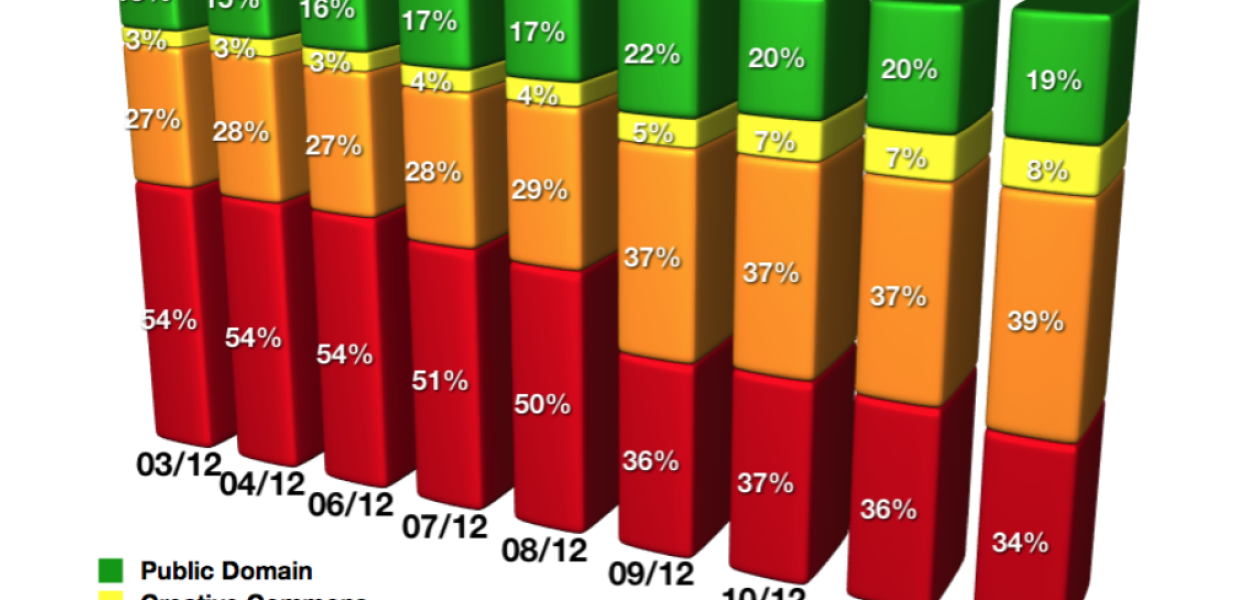Europeana Launches Rights Labelling Campaign

- Title:
- The changing levels of rights statements as a proportion of the published metadata, on a monthly basis over the course of 2012
- Creator:
- Kennisland
- Copyright:
- CC BY
This guest post from Paul Keller, vice chair of Kennisland, introduces Europeana's new 'Rights Labelling Campaign'.
In 2012, Europeana transitioned towards the new Europeana Licensing Framework. The most notable aspect of this transition was the release of Europeana metadata under the CC0 waiver in early September. 2013 began with the Europeana portal containing 23,595,557 metadata records that are freely available for re-use.
While making Europeana metadata available for re-use was the most visible change that came with the new licensing framework, it is not the only one. The new licensing framework also introduced rules for communicating the rights status of the digital objects to which the metadata in Europeana refers. The Europeana Data Exchange Agreement requires that data providers communicate the rights status of their objects by providing a rights statement through the 'europeana:rights' field. Data providers can choose from a predefined set of rights statements that cover the entire rights spectrum from Public Domain works to copyrighted works for which the rights holder reserves all rights and everything, such as Creative Commons licences, in-between.
The obligation to provide these rights statements is relatively new (the 'europeana:rights' field was only made mandatory with Europeana Semantic Elements version 3.4 from 31.03.2011) and as a result, not all metadata records in Europeana carry rights information about the digital objects to which they refer . The chart above shows the changing levels of rights statements as a proportion of the published metadata, on a monthly basis over the course of 2012. We, together with our data providers, have made good progress in reducing the amount of metadata records without rights statements. But at the end of 2012, 36% of all metadata records were still missing rights information.
Having good quality rights information about the objects that are available through Europeana is essential. We need to be able to communicate to our end-users if and how they can re-use the material that is being aggregated and published. Teachers need to know if they can use material they find via Europeana in the classroom or in readers. Publishers need this information if they wish to re-publish material they find via Europeana, and app developers and third-party services need rights information to ensure that services they build using the Europeana API do not infringe copyright. At the same time, good quality rights metadata improves the overall quality of the metadata and makes it a more valuable resource for all data providers and aggregators.
To address this, Europeana is starting a rights labelling campaign. Over the next couple of months, we will work with our data providers to ensure that all objects that are available via Europeana carry a valid rights statement. Throughout 2012, Kennisland and Europeana analysed the collections in Europeana with regards to the presence and quality of rights statements (summarised in this report, full research data here). Based on this analysis, we will approach data providers in two phases:
● In the first phase we will approach data providers who have provided collections that can be improved relatively easily. This means collections that are lacking rights statements for all records or collections where we have reason to believe that they carry the wrong rights statement for all records (for example a Creative Commons licence when the collection should be labelled as Public Domain). We will be asking data providers to review their collections and if they agree with our analysis to add/change the rights information. Once this has been done, the collections will be re-ingested into Europeana.
● In a second phase, we will approach data providers who have provided collections that we consider more difficult to improve. This refers to collection with different rights statements applying to different objects. We will provide data providers with as much information as possible with regards to which parts of the collections need updating and will be working with them in doing so. Once both parties have concluded that the rights statements are correct, these collections will be re-ingested into Europeana.
We understand that this process will require efforts from all parties involved and we hope to make it as smooth as possible. We aim to finish the first phase before the summer (which means that all datasets in Europeana should carry rights statements by then) and conclude the second phase by the end of 2013. Meanwhile, the ingestion team is ensuring that all new collections that are ingested into Europeana carry rights statuses in line with the Europeana Licensing Framework.
If you have questions, suggestions or feedback about the rights labelling campaign, please get in touch with us via [email protected]

